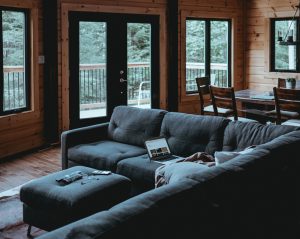 If you want to be energy efficient or stay warm on a budget, you are in luck. Keep reading to learn about ways to stay warm without increasing your energy bill or reinsulating your entire home.
If you want to be energy efficient or stay warm on a budget, you are in luck. Keep reading to learn about ways to stay warm without increasing your energy bill or reinsulating your entire home.
Check Your Glass Doors
Glass doors are often advertised as a positive feature. They provide natural light and a view of the outdoors. Unfortunately, glass is a terrible insulator. If you have touched a window on a cold day, you already know that. In extreme cases, it is noticeable cooler by a door than it is away from it. A frustrating and expensive amount of heat is lost through glass doors. There are several ways you can combat this heat loss. Replacing the door is always an option, either with a more energy-efficient glass door or one that is not made of glass. Newer glass doors usually have an additional insulator in the form of air or plastic that reduces heat loss. There are options that offer all of the benefits glass doors have with none of the associated costs.
There are other options if you do not want to replace your glass door. Simply hanging drapes in front of a glass door can be effective, even if you only close them at night. An estimated 25 percent of home heating costs stem from heat loss caused by windows, glass doors and skylights, so anything you do will make a difference.
Caulk Around Windows
Caulking around windows is a cheap and simple DIY project that can have enormous benefits. A tube of caulk will likely cost less than $10, depending on where you live and the brand you buy. Use the right type for the job to achieve the best results. There are exterior caulks designed specifically for outdoor use and humidity and mold-resistant ones for use in bathrooms.
Even if you have never caulked anything before, it is worth trying. There are numerous how-to YouTube videos available on the subject and even more articles offering advice. Only apply caulk to dry surfaces. You do not want to seal potentially damaging moisture into a crack, which will only cause more problems in the long run.
Use a Programmable Thermostat
Using a programmable thermostat is a great way to save money, as it allows you to be more energy-efficient. Hire someone to install it for you if you do not feel comfortable doing it yourself. It may be the most expensive advice on the list, but it is worth it. According to the EPA, using a programmable thermostat can reduce the cost of heating your home by up to 30 percent, if you use it correctly.
To take full advantage of your thermostat, program it to keep your home at 68 degrees Fahrenheit when you are awake and in the house. If you are sleeping or at work, set it to be 10-12 degrees cooler. This temperature is warm enough to keep your pipes from freezing while still saving you a considerable amount of money.
Buy a Humidifier
While it might sound counterintuitive, humid air holds more heat than dry air. Humidifiers are fairly affordable, and they are well worth the money. The EPA recommends keeping the humidity in your home between 30 and 60 percent for the best indoor air quality. At 40 percent humidity, 68 degrees Fahrenheit in your home will feel equivalent to 74 degrees when the humidity is at 20 percent.
In addition to saving money, using a humidifier will keep your home more comfortable. There are also potential health benefits. Increased humidity in your home may help alleviate allergies, coughs, dry skin and even sinus headaches.
Cook at Home
Cooking or baking at home during the winter is both cost and energy-efficient. Heat given off by your stove is heat your furnace does not have to produce. Since you have to eat, it is a great way to reduce heating costs during the winter months. Cooking at home has several added benefits. It is much cheaper than going out to eat, which will also save you money. It’s usually healthier too, and eating can help you feel warmer.
Complex carbohydrates are among the best foods to help you feel warmer. They increase thermogenesis, which is your body’s heat production. That means you can snack on whole wheat bread, potatoes, quinoa and oatmeal guilt-free this winter.
These are just some of the options available to increase your home’s energy efficiency while helping you stay warm this winter without breaking the bank. We hope you found this advice helpful and that you’re excited to implement these ideas.
If you end up making significant upgrades to your home, contact our offices to see how this might impact your insurance.

